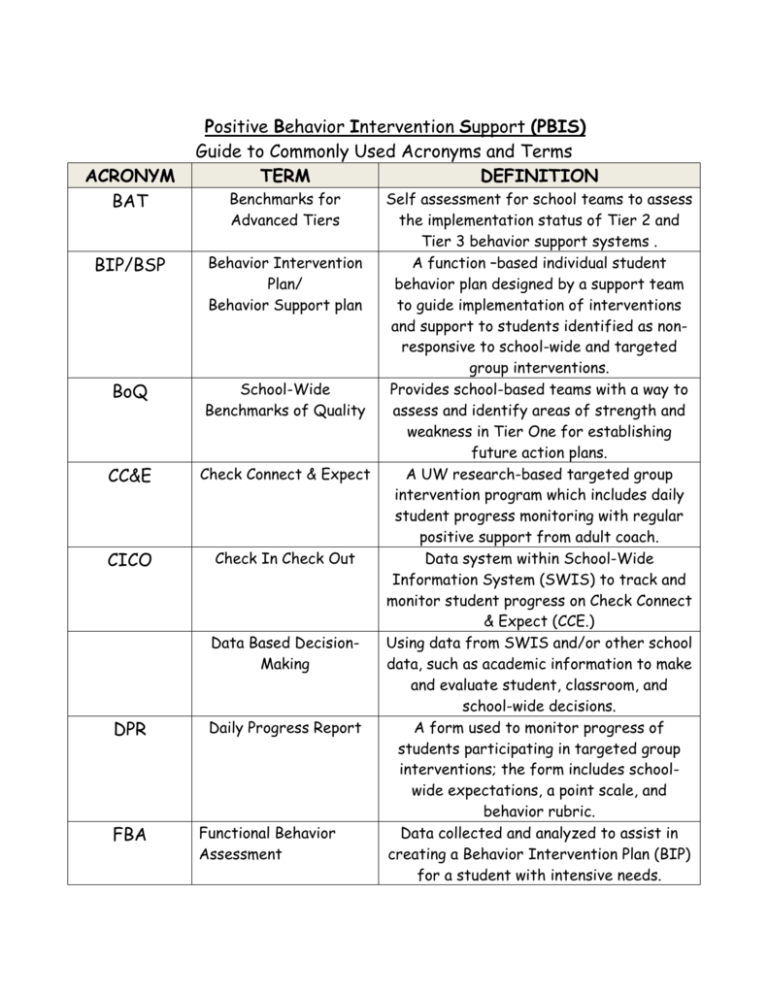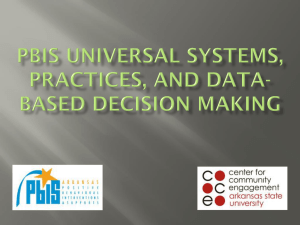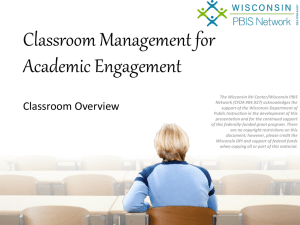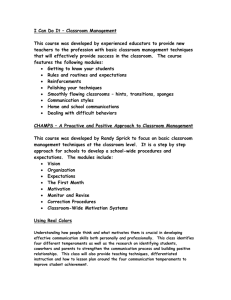Acronyms - NorthWest PBIS Network
advertisement

ACRONYM BAT Positive Behavior Intervention Support (PBIS) Guide to Commonly Used Acronyms and Terms TERM DEFINITION Benchmarks for Advanced Tiers BIP/BSP Behavior Intervention Plan/ Behavior Support plan BoQ School-Wide Benchmarks of Quality CC&E Check Connect & Expect CICO Check In Check Out Data Based DecisionMaking DPR FBA Daily Progress Report Functional Behavior Assessment Self assessment for school teams to assess the implementation status of Tier 2 and Tier 3 behavior support systems . A function –based individual student behavior plan designed by a support team to guide implementation of interventions and support to students identified as nonresponsive to school-wide and targeted group interventions. Provides school-based teams with a way to assess and identify areas of strength and weakness in Tier One for establishing future action plans. A UW research-based targeted group intervention program which includes daily student progress monitoring with regular positive support from adult coach. Data system within School-Wide Information System (SWIS) to track and monitor student progress on Check Connect & Expect (CCE.) Using data from SWIS and/or other school data, such as academic information to make and evaluate student, classroom, and school-wide decisions. A form used to monitor progress of students participating in targeted group interventions; the form includes schoolwide expectations, a point scale, and behavior rubric. Data collected and analyzed to assist in creating a Behavior Intervention Plan (BIP) for a student with intensive needs. ISS Individual Student System ISSET Individual Student Systems Tool Major Behavior Problems Minor Behavior Problems ODR PBIS Office Discipline Referral Positive Behavior Intervention Support PBIS Planning Team PBS POR Positive Behavior Support Positive office Referral Data system within School-Wide Information System (SWIS) to track and monitor individual student progress with Behavior Intervention Plan (BIP.) Available 2011 Research tool designed to assess the implementation status of Tier 2 and Tier 3 systems within a school by an outside evaluator. A pattern of minor infractions/referrals, intentional, dangerous, habitual, unsafe actions (used in SWIS.) First time offenses, developmentally typical, unintentional, accidental unsafe physical action, not purposeful (used in SWIS.) self explanatory The Behavior System within Response to Intervention (RTI): A proactive, preventative approach to increasing positive behavior through direct instruction. Uses three tiered intervention approach, research based interventions and data based decision making. Planning Team meets at least monthly to implement school-wide expectations, discipline and help make data driven decision-making. (Used interchangeably with PBIS; note NTPS uses “PBIS.”) Referral to school office for using positive behavior used a positive reinforcement for some students. RTI Response to Intervention SET School-Wide Evaluation Tool SSBD Systematic Screening for Behavior Disorders SST/CST Student Study Team/ Child Study Team SWIS School-Wide Information System SWPBS School-Wide Positive Behavior Support TIC Team Implementation Checklist An approach to helping all students learn. Provides academic and behavior interventions in a three tiered approach, using research based interventions and data based decision making. (Note: RTI refers to academic and behavior systems. Often the academic system is referred to as RTI and the behavior system as PBIS.) Annual assessment of school-wide PBIS which includes an interview with school staff and students about school-wide expectations and discipline policies by an outside evaluator. Annual or bi-annual school-wide behavior screening to identify students “at risk” and in need of PBIS secondary and tertiary interventions. A school-based team implementing, monitoring, and evaluating behavior support systems and individual student response to secondary and tertiary interventions. On-line data base that tracks school-wide discipline Office Discipline Referral data developed by the University of Oregon. A systems approach for establishing the social culture and behavioral supports needed for schools to be effective learning environments for all students. Used interchangeably with PBIS. Guides PBIS Team activities throughout the year; action planning and identifying technical assistance needs. Tier Three Behavior Support Team develops interventions for working with most Intensive/Individualized intensive students in the school through an Supports individualized function-based support plan “Red Zone” (FBA, BIP.) A secondary level of intervention for all Tier Two students not responding to the schoolTargeted Group wide/classroom support systems. Early Interventions identification of “at-risk” students “Yellow Zone” continues building efficient and rapid supports known by all staff and applied to a specific group of students. School-wide interventions occurring across Tier One Universal Interventions all settings with all students. Practices and systems focused on preventing problem “Green Zone” behaviors. Formation of PBIS Planning Team, school-wide expectations, discipline and implementation of SWIS and data driven decision-making. Tier Two The purpose of the inventory is to assist Action Planning Tier Two Leadership teams in a) assessing Checklist current status, b) determining items to add to the Team Action Plan and c) developing suggested artifacts and documentation to evaluate outcomes.




